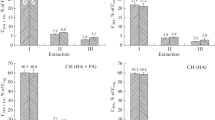Summary
Decomposition of humic acids suspended in a soil water-extract under various conditions of oxygen availability (aerobic, anaerobic, alternating aerobic/anaerobic) led to the formation of fulvic acids, lower molecular weight compounds, and humin, a more complex mixture of insoluble compounds. The transformation of humic acids and formation of new humic compounds were higher under aerobic conditions than under either anaerobic or alternating aerobic/anaerobic ones.
Although subjected to decomposition under greatly differing conditions of oxygen availability, the residual humic acids showed essentially the same types of chemical alterations, an increase of functional groups containing oxygen and a decrease of hydrolysable ternary and quarternary fractions.
Similar content being viewed by others
References
Blom L, Edelhausen L and Van Krevelen D W 1957 Chemical Structure and properties of coal, XVIII. Oxygen groups in coal and related products. Fuel 36, 135–153.
Brink R H, Dubach P and Lynch D L 1960, Measurement of carbohydrates in soil hydrolyzates with anthrone. Soil Sci. 89, 157–166.
Burgess N A and Latter A 1960 Decomposition of humic acid by fungi, Nature 186, 404–405.
DeWalt C W and Glenn R A 1952 Analytical acetylation-application to coal hydrogenation products. Anal. Chem. 24, 1789–1795.
Emtsev V T and Shelley S T 1984 Decomposition of humic compound by soil anaerobic bacteria. 2ND JHSS Meeting in Birmingham, July 22–28.
Freytag H E 1962 Über einige Analogien im Verlauf pflanzlicher und synthetischer Humifizierungsprozesse. Studies about Humus, Symposium on Humus and Plants, Prague, Chechoslovakia 75–87.
Kobo K and Tatsukawa R 1959 On the coloured material of fulvic acids. Z. Planzenernähr. Düng. Bodenk. 84, 137–147.
Ladd J N 1969 The extintion coefficients of soil humic acid fractionated by Sephadex gel filtration. Soil Sci. 107, 303–306.
Mathur S P and Paul E A 1967a Microbial utilization of soil humic acids Can. J. Microbiol. 13, 573–580.
Mathur S P and Paul S P and Paul E A 1967b Partial characterization of soil humic acids through biodegradation. Can. J. Microbiol. 13, 581–586.
Mishustin E N and NiKitin DI 1961 Destructibility of humic acids by soil microflora. Some characteristics of structure of humic acids. Microbiology (URSS) 30, 841–848.
NaKhla S M and Delibrias G 1967 Utilsation de carbon-14 d'origine thermonucléaire pour l'etudie de la dynamique du carbon dans le sol. Radioactive Dating and Methods of Low-Level counting (Proc. Symp. Monaco), IAEA, Vienna.
Ostlund H G and Engstrand L G 1963 Stockholm Radiocarbon Measurement V., Radiocarbon 5, 203.
Paul E A, Campbell C A, Rennie D A and McCallum K J 1964 Investigations of the dynamics of soil humus utilizing carbon dating techniques, Proc. 8th Int. Congr. Soil Science III, Bucharest.
Charpenseel H W 1961 Herstellung und Reinigung von Tritium-markierten Grau-und Braunhuminsaurepräparaten sowie von tritium-Purpuro-gallin, Z. Pfl Ernähr. Düng. Bodenk 91, 131–146.
Scharpenseel H W 1984 Biotic, abiotic, and photochemical degradation of14C labelled fulvic acids, humic acids, and wheat straw under various environmental conditions. 2nd JHSS Meeting in Birmingham, July 22–28.
Scheffer F, Ziechmann W and Schluter H 1955 Die Papierelektrophorese als Möglichkeit der Auftrennung von Huminsäuren Z. Pflanzenernähr, Düng. Bodenk 70, 260–274.
Schnitzer M 1978 Humic substances: chemistry and reactions.In Soil Organic Matter. Eds. M Schnitzer and S U Khan, Elsevier Scientific Publishing Company, New York, 1–64.
Snell F D and Snell C T 1953 Colorimetric Methods of Analysis Vol. III, D. Van Nostrand Company Inc. Princeton, New Jersey.
Troll W and Cannon K 1953 A modified photometric ninhydrin methods for the analysis of amino and imino acids. J. Biol. Chem. 200, 803–811.
Tsutsuki K and Kuwatsuka S 1978 Chemical studies on soil humic acids. II Composition of Oxygen-containing functional groups of humic acids. Soil Sci. Plant Nutr. 24, 547–560.
Tsutsuki K and Kuwatsuka S 1979 Chemical studies on soil humic acids. IV Amino acid, Phenol and Sugar composition in the acid Hydrolysable fraction of humic acids. Soil Sci. Plant Nutr. 25, 29–38.
Wagner G H 1968 Significance of microbial tissues to soil organic matter. Isotopes and Radiation in Soil Organic Matter Studies (Proc. Symp. Vienna) 197–205.
Author information
Authors and Affiliations
Rights and permissions
About this article
Cite this article
Ramunni, A., Scialdone, R. & Felleca, D. Decomposition of humic acids by incubation in a soil water-extract under various conditions of oxygen availability. Plant Soil 97, 15–23 (1987). https://doi.org/10.1007/BF02149819
Received:
Revised:
Issue Date:
DOI: https://doi.org/10.1007/BF02149819




